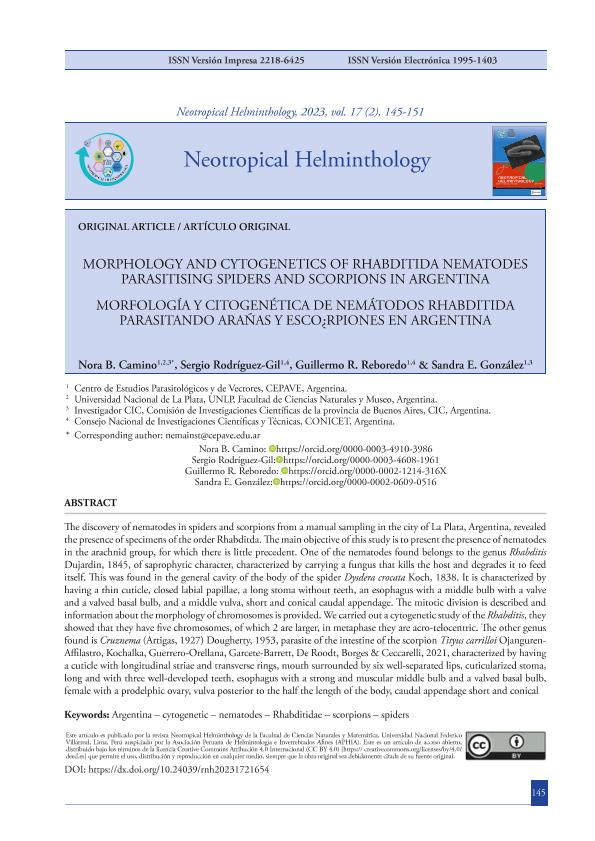Artículo
El hallazgo de nematodos en arañas y escorpiones, fruto de habituales y sistemáticos de muestreos manuales de arácnidos en la ciudad de La Plata, Argentina, reveló la presencia de ejemplares del orden Rhabditda. Este estudio tiene como objetivo comunicar la presencia de nematodos en el grupo arácnidos, del cual hay escasos y limitados antecedentes. Uno de los nematodos hallados pertenece al género Rhabditis Dujardin, 1845, de carácter saprófito, caracterizado por llevar en el esófago un hongo que al matar al hospedador lo degrada para poder alimentarse. Este se halló en la cavidad general del cuerpo de la araña Dysdera crocata Koch, 1838. El mismo se caracteriza por tener la cutícula fina, papilas labiales cerradas, estoma largo, sin dientes, esófago con bulbo medio con valva y bulbo basal valvado, vulva media, apéndice caudal corto y cónico. Se describe la división mitótica y se aporta información acerca de la morfología de los cromosomas. Se realizó un estudio citogenético de los Rhabditis, los mismos mostraron poseer cinco cromosomas, de los cuales 2 son más grandes, en metafase, son acro-telocéntricos. El otro género hallado es Cruznema (Artigas, 1927) Dougherty, 1953, parásito del intestino del escorpión Tityus carrilloi Ojanguren-Affilastro, Kochalka, Guerrero-Orellana, Garcete-Barrett, De Roodt, Borges & Ceccarelli, 2021, caracterizado por tener una cutícula con estrías longitudinales y anillos transversales, boca rodeada de seis labios bien separados, estoma cuticularizado, largo y con tres dientes bien desarrollado, esófago con un bulbo medio fuerte y musculoso y un bulbo basal valvado, hembra con un ovario prodélfico, vulva posterior a la mitad de la longitud del cuerpo, apéndice caudal corto y cónico. Th e discovery of nematodes in spiders and scorpions from a manual sampling in the city of La Plata, Argentina, revealed the presence of specimens of the order Rhabditda. Th e main objective of this study is to present the presence of nematodes in the arachnid group, for which there is little precedent. One of the nematodes found belongs to the genus Rhabditis Dujardin, 1845, of saprophytic character, characterized by carrying a fungus that kills the host and degrades it to feed itself. Th is was found in the general cavity of the body of the spider Dysdera crocata Koch, 1838. It is characterized by having a thin cuticle, closed labial papillae, a long stoma without teeth, an esophagus with a middle bulb with a valve and a valved basal bulb, and a middle vulva, short and conical caudal appendage. Th e mitotic division is described and information about the morphology of chromosomes is provided. We carried out a cytogenetic study of the Rhabditis, they showed that they have fi ve chromosomes, of which 2 are larger, in metaphase they are acro-telocentric. Th e other genus found is Cruznema (Artigas, 1927) Dougherty, 1953, parasite of the intestine of the scorpion Tityus carrilloi OjangurenAffi lastro, Kochalka, Guerrero-Orellana, Garcete-Barrett, De Roodt, Borges & Ceccarelli, 2021, characterized by having a cuticle with longitudinal striae and transverse rings, mouth surrounded by six well-separated lips, cuticularized stoma, long and with three well-developed teeth, esophagus with a strong and muscular middle bulb and a valved basal bulb, female with a prodelphic ovary, vulva posterior to the half the length of the body, caudal appendage short and conical.
Morfología y citogenética de nemátodos Rhabditida parasitando arañas y escorpiones en Argentina
Título:
Morphology and cytogenetics of Rhabditida nematodes parasitising spiders and scorpions in Argentina
Camino, Nora Beatriz; Rodríguez Gil, Sergio Gustavo ; Reboredo, Guillermo Raul
; Reboredo, Guillermo Raul ; González, Sandra E.
; González, Sandra E.
 ; Reboredo, Guillermo Raul
; Reboredo, Guillermo Raul ; González, Sandra E.
; González, Sandra E.
Fecha de publicación:
10/2023
Editorial:
Asociación Peruana de Helmintología e Invertebrados Afines
Revista:
Neotropical Helminthology
ISSN:
2218-6425
e-ISSN:
1995-1043
Idioma:
Español
Tipo de recurso:
Artículo publicado
Clasificación temática:
Resumen
Palabras clave:
ARAÑAS
,
ARGENTINA
,
CITOGENÉTICA
,
ESCORPIONES
,
NEMATODOS
,
RHABDITIDAE
Archivos asociados
Licencia
Identificadores
Colecciones
Articulos(CEPAVE)
Articulos de CENTRO DE EST.PARASITOL.Y DE VECTORES (I)
Articulos de CENTRO DE EST.PARASITOL.Y DE VECTORES (I)
Citación
Camino, Nora Beatriz; Rodríguez Gil, Sergio Gustavo; Reboredo, Guillermo Raul; González, Sandra E.; Morfología y citogenética de nemátodos Rhabditida parasitando arañas y escorpiones en Argentina; Asociación Peruana de Helmintología e Invertebrados Afines; Neotropical Helminthology; 17; 2; 10-2023; 145-151
Compartir
Altmétricas



